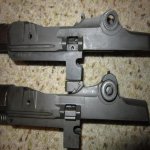By the way, don't panic. As cast guns go, that one is not that bad looking and there is ZERO evidence that there are any issues with the cast receivers so far.
One check I would do though:
Remove the op rod and with the action out of the stock, insert the bolt.
Bring the bolt almost into battery and check when it rotates enough that the firing pin will slip past the safety bridge. Hopefully the bolt lugs are almost totally engaged before the firing pin can move forward.
On a cast receiver, firing pin timing is the thing that would give me the most potential concern from a safety perspective. But if it checks out, then likely it will be fine.
One check I would do though:
Remove the op rod and with the action out of the stock, insert the bolt.
Bring the bolt almost into battery and check when it rotates enough that the firing pin will slip past the safety bridge. Hopefully the bolt lugs are almost totally engaged before the firing pin can move forward.
On a cast receiver, firing pin timing is the thing that would give me the most potential concern from a safety perspective. But if it checks out, then likely it will be fine.








































































